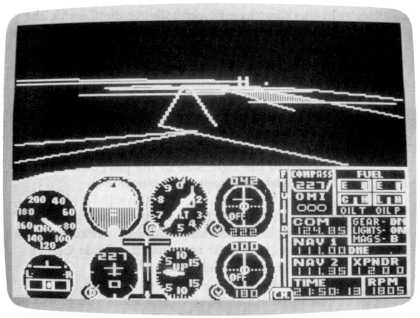40 More Great Flight Simulator Adventures
by Charles Gulick

An
Attraction
of Opposites
The Manhattan Project V
of Opposites
The Manhattan Project V
| North Position: 17068 | Rudder: 32767 |
| East Position: 20995 | Ailerons: 32767 |
| Altitude: 23 | Flaps: 0 |
| Pitch: 0 | Elevators: 32767 |
| Bank: 0 | Time: 21:30 |
| Heading: 45 | Season: 2-Spring |
| Airspeed: 0 | Wind: 3 Kts, 50 |
| Throttle: 0 |
| In this direction, if you're
flying the Cessna, the edge of the
pavement nicely defines the right side of the strip, nominally runway 4
(night) at your airport. In the Piper, radar offers a better
positioning reference. |
|
 |
Look at your position on radar,
and you'll see that you're indeed at
the end of the runway, just beyond Edge Road and where it juts out, and
well situated to the right side of the pavement (which is the right
side for landing, too). Now the Empire State Building, or a portion of it, is visible out the left front. Manhattan Bridge, of course, is to your rear, and the Trade Center should be at your left rear. |
 |
This time, after taking off,
I'll show you a neat little trick, one that will be a valuable part of
your repertoire. Make your normal roll and liftoff, using ten degrees of flaps, but as soon as you dump them, slowly reduce your power to turn about 1600 to 1650 rpm. |
 |
Take a rear view and watch for
Queensboro Bridge to appear. When it
does, pause for a moment and take in the scene. The horizontal line
after the Queensboro, the line extending from 42nd Street, delineates
the northern extremity of your airport and the threshold of runway 4
nominal. This is the picture you'll have, approximately, on final
approach. This is a good time to mention again that, on making a landing approach, your main concern should be with the runway perspective and your general surroundings, not with having or keeping an exact heading. Many runways, yours included, don't bear exactly on the runway numbers. The numbers are, after all, ten degrees apart. A runway 22 might actually point 216, 224, and so on, rather than exactly 220. And when you're making a small heading correction to line up, the literal straightness of your line in relation to the strip goes haywire anyhow. So land on the runway, not on its number. |
 |
Before you unpause, read and
plan to execute the following: • After you unpause, return to your out-the-windshield view. • Enter the editor. • Make this single modifictation-change your heading to 215, the exact reciprocal of your present heading. • Exit the editor. You'll be on final approach to the runway you just left. • Land there. It's a downwind landing. The wind is only a few knots, though. But this is a useful trick for examining a strange airport under night conditions, or day conditions for that matter. Remember that your most desirable landing on your night runways is to the side nearest the grass, and that side is pointed to by the extended line of 42nd Street, and indicated by the blank space between the end of that street and FDR Drive, which is at right angles. Using your eyes creatively, you can visualize a runway, the perspective of which begins where 42nd Street points and ends where Edge Road crosses your path (and in the Cessna, the Manhattan pavement juts out and ahead to join the river). Our exploration of your Manhattan airport in this book is nearly complete. There's just one more. But your exploration will almost surely continue as long as you fly this simulator. I think you'll come to accept your airport as a real entity, and a most convenient, picturesque, and realistic one. The nice part of it is that the people who live in the vicinity will never know the difference. Unless, of course, you live there. Which, come to think of it, is a possibility. |
Table of Contents | Previous Section | Next Section
